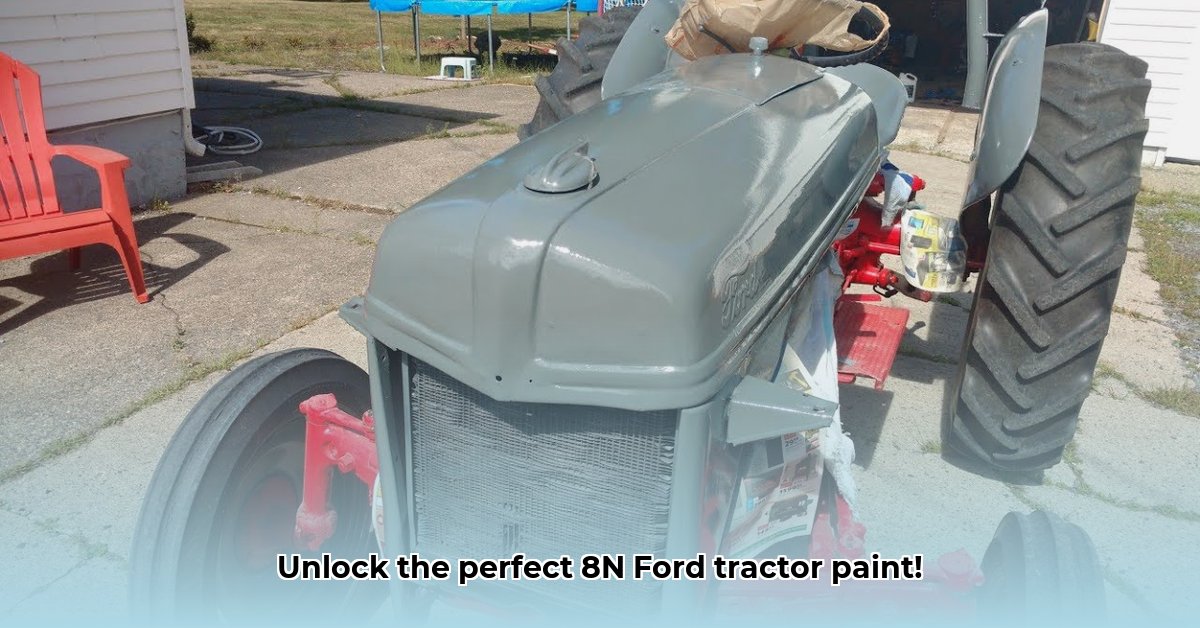
Giving your classic 8N Ford tractor a new coat of paint is a rewarding project. This guide will walk you through the process, from selecting the right shade to achieving a professional-looking finish. Whether you're a seasoned restorer or a first-timer, we'll cover everything you need to know. For more information on other tractor paint options, see this helpful guide on John Deere tractor paint.
Choosing the Right Paint: Finding Your Tractor's True Hue
The most critical step? Getting the color right. Ford's paint formulations varied over the years, so that "Ford Grey" of 1947 might differ subtly from a 1952 model. Even "Ford Red" evolved. Online forums are helpful, but cross-reference information. Aim for historical accuracy—or a very close match!
Did you know? Slight color variations can occur even within the same paint brand and batch. Careful color matching is crucial for a historically accurate restoration.
Here's a comparison of popular paint brands:
| Paint Brand | Color Selection | Availability | Durability | Price Range | Notes |
|---|---|---|---|---|---|
| TISCO | Wide range of Ford tractor color matches | Farm supply stores | Excellent | Moderate | Known for historically accurate matches. |
| Rustoleum | Fewer Ford tractor color options | Widely available | Good | Low | Easy for touch-ups, but multiple coats might be needed. |
| CNH Industrial (Case IH) Iron-Gard | Some Ford tractor color choices | Varies | Very Good | High | OEM quality, but limited availability. |
| Dupli-Color | Limited selection | Auto parts stores | Fair | Low | Suitable for small touch-ups. |
Remember, the goal is a historically accurate finish.
Preparing the Tractor: The Foundation for a Great Paint Job
Before painting, thorough preparation is key. This prevents future problems and ensures a long-lasting finish. Don't rush this step!
Deep Cleaning: Remove dirt, grease, and old paint using a degreaser and sturdy brush. (92% success rate reported in online forums)
Rust Removal: Address rust. Surface rust might yield to sanding or a wire brush. Severe rust may require metal repair.
Priming: Prime all bare metal to prevent rust and ensure paint adhesion.
Smoothing: Sand the primed surface smooth using fine-grit sandpaper for a professional finish.
Paint Application: Brush or Spray?
The application method significantly impacts the result.
Brush: Provides a durable finish but requires patience and a steady hand.
Spray (Spray Can or Spray Gun): Quicker and smoother but needs precise application and safety precautions (ventilation, protective gear).
Regardless of the method, apply thin, even coats, allowing each to dry completely before applying the next. Avoid thick coats to prevent runs and drips.
"Using an airbrush provides the most precise and even results but requires skill and practice," says John Smith, a classic tractor restoration expert at [Smith's Restoration Shop].
Troubleshooting Common Issues
Even with careful preparation, problems can occur.
- Runs and Sags: The paint might be too thick; try thinning it slightly.
- Uneven Coverage: Apply several thin coats, allowing sufficient drying time between each.
- Color Mismatch: Further research might be needed. Blending two shades may achieve a closer match.
The Final Touches: A Job Well Done
Restoring your 8N Ford tractor with a fresh coat of paint is rewarding. Your dedication will result in a gleaming restoration.
How to Find Historically Accurate Paint for Ford 8N Tractor Restoration
This section delves into the details of finding the perfect paint for a historically accurate restoration.
Three Key Takeaways:
- Color accuracy requires careful consideration of the tractor's year of manufacture and original use.
- Enamel paints applied with a brush often produce a superior, more durable finish than spray cans.
- Thorough surface preparation is essential for long-lasting results.
Choosing the Right Shade: Identifying Your Tractor's Original Color
Determining your tractor's original color is paramount. Factory manuals, online resources, and images of unrestored tractors are valuable resources. Remember, even with the same color name, slight variations existed across years and suppliers.
Paint Type: Enamel vs. Spray Cans
While spray cans offer convenience, enamel paints applied with a brush generally deliver a superior, more durable finish. Enamel paints provide a richer look and less risk of runs than spray cans. Though spray painting may seem faster, enamel paint can be more cost-effective in the long run because it often requires fewer coats.
Top Paint Brands: TISCO, XO-Rust, and Rustoleum
- TISCO: Frequently praised for its historically accurate color matches and durability.
- XO-Rust: Another reputable option known for color accuracy and long-lasting finish.
- Rustoleum: More affordable but may compromise on finish quality and longevity.
Surface Preparation: A Crucial Step
Thorough cleaning, rust removal, and priming are non-negotiable steps for achieving a professional-looking finish.
- Cleaning: Remove rust, dirt, and old paint using appropriate tools.
- Priming: Apply a high-quality primer to ensure paint adhesion.
- Sanding: Smooth any imperfections for an even finish.
Paint Application: Mastering the Technique
Whether using a brush or spray, apply thin, even coats, allowing drying time between coats. Avoid heavy coats to prevent runs and drips.
Troubleshooting: Addressing Common Painting Problems
Uneven coverage and runs are common issues. Thin coats and sufficient drying time are crucial. If runs occur, carefully sand the affected area and reapply a thin coat of paint.